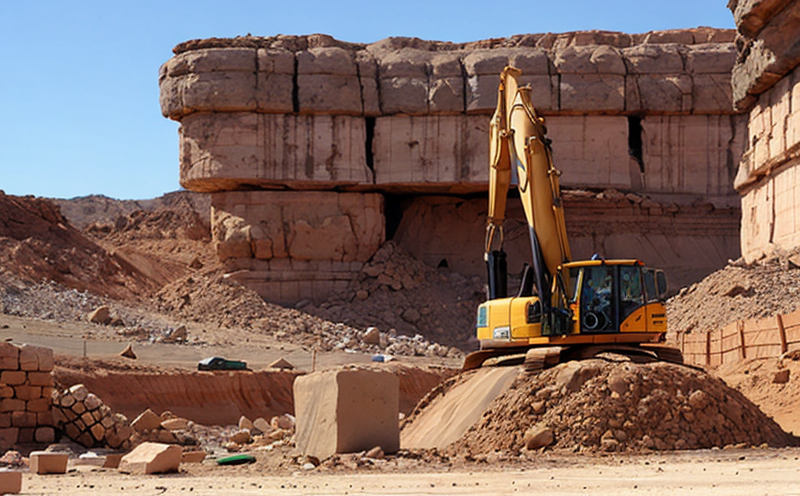ISO 17892 Triaxial Compression Testing of Soil and Rock
The ISO 17892-1 standard specifies a method for determining the mechanical properties of soil and rock specimens subjected to triaxial compression. This test is essential in mining operations where understanding the strength, deformation behavior, and failure mechanisms under stress is critical.
Rock mechanics plays a pivotal role in ensuring safety and efficiency in underground mining activities. The mechanical properties of rocks are influenced by their mineralogy, grain size, porosity, and water content, among other factors. These properties directly impact the structural integrity of mine tunnels, shafts, and supporting structures. Accurate determination of these properties through triaxial compression testing provides crucial data for designing safe and robust underground infrastructure.
The test involves applying a controlled axial load to a cylindrical specimen while simultaneously confining it in all directions using hydrostatic pressure. This setup simulates the stress conditions encountered in mining environments, where rocks are subjected to complex loading scenarios due to excavation and overburden pressures. The deformation of the rock specimen under these conditions is measured, allowing for the calculation of key parameters such as uniaxial compressive strength, modulus of elasticity, Poisson's ratio, and more.
Testing in accordance with ISO 17892 ensures that the data obtained is consistent, reproducible, and comparable across different laboratories. This standardization is vital for quality assurance and compliance with international regulations in mining operations. The results from this testing are used by geotechnical engineers to make informed decisions regarding excavation plans, support systems, and infrastructure design.
Understanding rock mechanics through triaxial compression tests helps mitigate risks associated with underground mining. By identifying the critical stress points and failure modes of rocks, miners can implement proactive measures to prevent accidents and improve operational efficiency. This testing method is widely used in various applications within the mining sector, including:
- Evaluation of rock mass stability
- Design of ground support systems
- Optimization of excavation methods
- Assessment of rock fragmentation during blasting operations
The process begins with the selection and preparation of appropriate specimens. Specimens are typically cylindrical in shape, with dimensions specified according to ISO 17892-1. Proper specimen preparation is crucial as it directly affects the accuracy of the test results.
Once prepared, the specimens are placed into a triaxial testing apparatus that can apply both axial and confining pressures. The test proceeds by gradually increasing the axial load while maintaining constant hydrostatic pressure. During this process, continuous monitoring of deformation is conducted using strain gauges or other suitable instruments. This data is used to plot stress-strain curves, which provide valuable insights into the mechanical behavior of the rock specimen.
The results from these tests are then analyzed in accordance with ISO 17892-1 guidelines. Acceptance criteria for the test include specific limits on allowable deviations and acceptable ranges for various parameters. Compliance with these standards ensures that the testing meets international quality benchmarks, thereby enhancing confidence in the accuracy of the data.
In conclusion, ISO 17892 triaxial compression testing is an indispensable tool for ensuring safety, reliability, and efficiency in mining operations. By accurately determining the mechanical properties of rock specimens under controlled conditions, this test method supports informed decision-making processes across various aspects of underground mining activities.
Applied Standards
| Standard Name | Reference Number | Description |
|---|---|---|
| ISO 17892-1:2015 | Triaxial Compression Testing of Soil and Rock | This standard specifies the procedure for determining the mechanical properties of soil and rock specimens under triaxial compression. |
EuroLab offers state-of-the-art facilities designed specifically to perform ISO 17892 triaxial compression testing. Our experienced technicians are well-versed in the intricacies of this method, ensuring accurate and reliable results every time.
We utilize top-tier equipment that adheres strictly to international standards, guaranteeing precision and consistency in our tests. This ensures that clients receive data they can trust for their critical applications. Our comprehensive service package includes not only testing but also detailed reporting tailored to meet the specific needs of mining operations.
Moreover, EuroLab's commitment to quality is reflected in our robust quality management systems. We are ISO 9001 certified, ensuring that all processes are meticulously documented and regularly audited. This commitment translates into consistently high-quality results for every client.
Quality and Reliability Assurance
- Compliance with ISO 17892-1 standards
- Use of calibrated and maintained equipment
- Trained and certified personnel
- Detailed documentation and reporting
- Continuous quality assurance checks
- Regular calibration and validation of instruments
- Client consultation during the testing process





